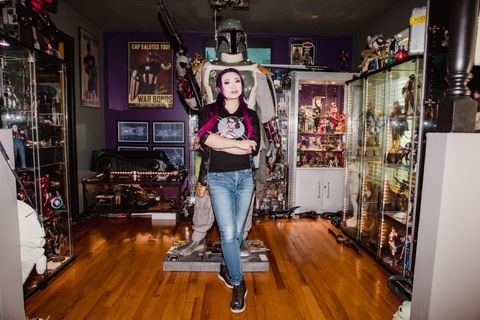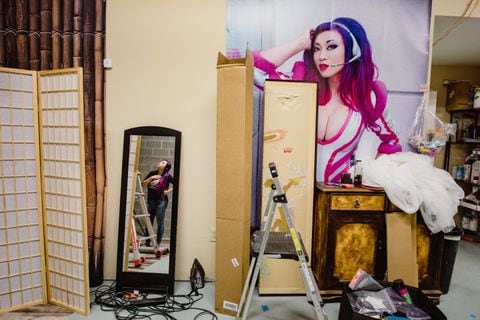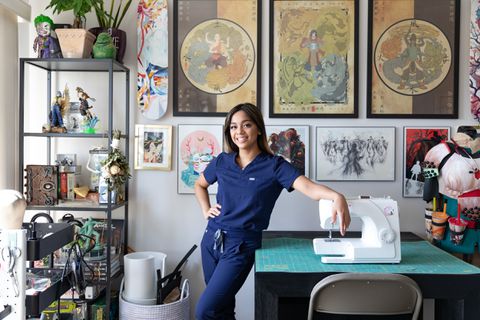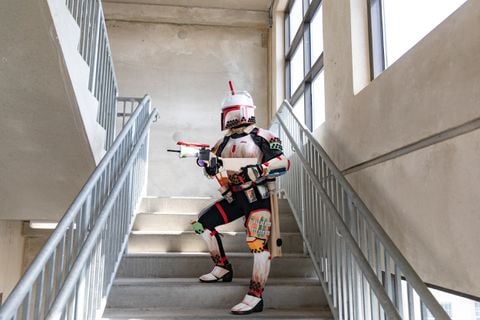All dressed up with nowhere to go: Cosplaying in the pandemic
It took Michelle Anderson a month to create her E3 2019 outfit. It took her another hour to put it on. She wore a wig with red Afro puffs, an army-green tactical vest and fake bloodstained bandage. She completed the look with medical gloves and a mask looped around her neck, then took one last look in the mirror before she headed out the door. She was dressed as Lifeline, a playable combat medic from the video game “Apex Legends.”
Anderson is a cosplayer, a person who dresses up as a fictional character from a video game, book, or film. A portmanteau of “costume” and “play,” cosplay has been steadily growing in popularity as a hobby, and sometimes even a profession. Wherever fans congregate, be that on social media or at in-person conventions, cosplayers can be found dressed up, and sometimes even performing as, their favorite characters.
Anderson’s screen-accurate outfit, complete with a high-tech healing drone accessory, made a big impact on E3 2019 attendees.
“I even had a girl who was crying when she saw me, saying ‘I main you, can I take a picture with you?’” Anderson said. “That feeling is amazing. The warmth of the community is amazing.”
 Cosplay has been steadily growing in popularity as a hobby, and sometimes even a profession. (Amy Osborne for The Washington Post)
Cosplay has been steadily growing in popularity as a hobby, and sometimes even a profession. (Amy Osborne for The Washington Post) She had no idea it would be among the last times she would cosplay in public.
The following year, most of the United States went into lockdown to mitigate the covid-19 pandemic. As an essential front-line worker, Anderson didn’t have the privilege of staying home. Working in the San Francisco Bay area for a cable and Internet company, Michelle’s job was deemed critical to the new work-from-home paradigm. Each day she went to work wearing the same type of medical gloves from her Lifeline cosplay, but for a very different reason.
“I’m happy I was able to help other people work from home and stay safe,” she said. “But, and I’m getting emotional thinking about this, it was really stressful. I had to worry if I was going to get covid or not because I was seeing hundreds of people a day.”

Anderson shows one of her costumes on her phone. (Amy Osborne for The Washington Post)

Anderson applies makeup while dressing in one of her elaborate costumes. (Amy Osborne for The Washington Post)
LEFT: Anderson shows one of her costumes on her phone. (Amy Osborne for The Washington Post) RIGHT: Anderson applies makeup while dressing in one of her elaborate costumes. (Amy Osborne for The Washington Post)
To unwind from a job that was alternately exhausting and scary, she turned to her favorite hobby: cosplay. Anderson, like most cosplayers, was accustomed to planning her outfits around events. When they disappeared, she found herself adrift. But in that uncertain period, Anderson and other cosplayers around the country applied the same creativity they showed in making their costumes toward new ways to share them.
Ejen Chuang, a cosplay photographer and the author of Cosplay In America, said that based on his informal polls in the fandom, it wasn’t unusual for cosplayers to have pared down their participation during the pandemic. However, there have been a few opportunities over the past year: Even as some events took on a virtual format, a handful brought cosplay along with them. Hashtags like Anime Expo’s #MaskYourMasquerade and #DragonConGoesVirtual encouraged cosplayers to show off their looks and win prizes, even while they were staying safe at home.
Some cosplayers also found ways to meet safely in person during the pandemic. Chuang organized multiple socially-distanced photoshoots in his local Austin, Texas. By shooting with a long lens, he could photograph from six feet away or more while simulating proximity.
“You usually show the back of the camera to the cosplayer as you go,” he said, referring to the LCD screen found on the photographer’s side of a modern digital camera. “What I had to do was put my camera on a bench, walk six feet away, and then the cosplayer would look at the camera, give me feedback, walk away, and then I would pick it up again.”
 For Yaya Han, cosplaying is a full-time job. (Dustin Chambers for The Washington Post)
For Yaya Han, cosplaying is a full-time job. (Dustin Chambers for The Washington Post) For career cosplayers, the event-focused nature of the work threatened their livelihood. Professional cosplayers pay their bills with event appearances; cancellations mean canceled paychecks. Yaya Han, a professional cosplayer, needed to come up with a Plan B.
Since beginning as a hobbyist in her teens, Han has spent the past few decades perfecting her craft. Through a combination of paid event appearances, selling signed merchandise, designing cosplay patterns, fabric and trims for mass retail, and operating a cosplay accessories and materials store with three full-time employees (her husband and two fellow cosplayers) it is now her full-time job. Or it was, before everything changed.
“I really thought that my career was set,” Han said. “I’d just written a book introspecting on my past 20 years of cosplay. The pandemic has really upended my mind-set and made me think about what my next steps are.”
What came next gave Han “multiple tiers of dread and worry.” With family members living in China, she worried about their health and survival. With all of her cosplay appearances canceled, she was also worried about keeping her three employees paid. The pandemic also sparked a tinderbox of Anti-Asian sentiment in her home of Atlanta, Georgia. Han still avoids going out alone.

Han operates a cosplay accessories and materials store with three full-time employees. (Dustin Chambers for The Washington Post)

Since beginning as a hobbyist in her teens, Han has spent the past few decades perfecting her craft. (Dustin Chambers for The Washington Post)
LEFT: Han operates a cosplay accessories and materials store with three full-time employees. (Dustin Chambers for The Washington Post) RIGHT: Since beginning as a hobbyist in her teens, Han has spent the past few decades perfecting her craft. (Dustin Chambers for The Washington Post)
But most of all, Han was overwhelmed by the sheer loss of life. While she thought about what to do next, she began sewing face masks for elderly neighbors, and then delivering hundreds of them to her local hospitals. Since Han runs a cosplay shop where she sells supplies and handmade accessories for cosplayers, she already had a ready supply of the cotton fabric and elastic ties that could be difficult to source in the early days of the pandemic. Eventually, Han taught her employees to craft masks and began offering them in her shop alongside cosplay props. This helped keep the small business afloat.
“I realized I could either cut everyone’s hours, or I could teach them how to make face masks and figure out the system of working from home, avoiding each other, while still making this new product,” she said.
The other component of Han’s new career was a burgeoning new pandemic-based field of remote sponsored cosplay. In one example, Han was approached by a marketing team working with Capcom’s “Resident Evil Village,” a horror-focused shooter starring the villainous vampire Lady Dimitrescu. Han was given two weeks to create the outfit, design a background set, take pictures and video and post it to all of her social media with specified hashtags and phrasing. The process culminated in an 11-hour shoot with her husband and photographer Brian Boling. The company compensated her with a four-figure payment.
 “The pandemic has really upended my mind-set and made me think about what my next steps are,” said Han. (Dustin Chambers for The Washington Post)
“The pandemic has really upended my mind-set and made me think about what my next steps are,” said Han. (Dustin Chambers for The Washington Post) “It’s difficult to gauge your worth,” Han said. “I have all these years of experience negotiating conventions. But this brought me back to a starting point. I’m a noob again. I’m still learning.”
These days, when Han partners with a company, she signs a nondisclosure agreement before she even knows which character she will be cosplaying. That same NDA keeps her from sharing progress shots or discussing costume construction with other members of the cosplay community. It’s not clear how sustainable this new income stream will be moving forward, Han said.
“During the pandemic, a lot of these companies shifted to online promotions because they didn’t have events either,” she said. “Once events come back, will they even want me to do these types of collaborations?”
Despite all the changes and turmoil, Han remains hopeful. “I have survived more than 20 years,” she said. “I’m sure I will find a way to move forward.”
For hobbyists as well, social media replaced events as the ultimate destination to show off a costume. In the middle of 2020, Anderson joined the video-sharing social network TikTok and found a new way to network with other cosplayers. A video of Anderson modeling several of her cosplays to a Nicki Minaj song netted tens of thousands of views.
“Stuff like that kept me sane because it showed me that I was still able to have fun with my community, even in a pandemic,” said Anderson. “It kept my confidence up.”
 ICU nurse Marie Chante Ramos found solace among fellow cosplayers in the health industry. (Melanie Landsman for The Washington Post)
ICU nurse Marie Chante Ramos found solace among fellow cosplayers in the health industry. (Melanie Landsman for The Washington Post) Marie Chante Ramos, an ICU nurse and cosplayer, also turned to social media during the pandemic, though she didn’t have much time to post her costumes at first. Working night shifts at Raritan Bay Medical Center in Old Bridge, New Jersey, she saw so many covid-19 patients that the small hospital’s ICU was overflowing for months.
“When we got our first covid patient in the ICU, it was almost like war was coming,” Ramos said. “Even nurses who had 30-plus years of experience were shaken.”
Ramos found solace among fellow cosplayers in the health industry. In a group chat, she and others shared their experiences, encouragement and the occasional cosplay meme. One of the most popular memes in the early days of the pandemic was the #passthebrush challenge, in which participants simulate passing a makeup brush, briefly blotting out the screen with its bristles before revealing a dramatic cosplay transformation. That gave Ramos an idea. What if she and her friends did the same thing, but with a stethoscope?

Marie Chante Ramos adjusts her Boba Fett costume. (Melanie Landsman for The Washington Post)

Marie Chante Ramos looks through her collection of convention badges. (Melanie Landsman for The Washington Post)
LEFT: Marie Chante Ramos adjusts her Boba Fett costume. (Melanie Landsman for The Washington Post) RIGHT: Marie Chante Ramos looks through her collection of convention badges. (Melanie Landsman for The Washington Post)
“We are health care professionals, but we transform ourselves into whoever we want to be through cosplay. So I told the chat, ‘Hey, wouldn’t it be cool if we did a video in our PPE garb?’” Ramos said.
With their bodies concealed by head-to-toe PPE, Ramos knew that it was easy for patients and the public to see them as a faceless bloc instead of real people who were just as, if not more so, emotionally impacted by the daily loss of life. The resulting video, “Heroes behind the PPE,” shows Ramos and 22 other cosplayers sharing their dual roles as first responders and costumed heroes. At the time of this publication, the video has nearly half a million views.
“I liked being able to shine some light on these health care professionals who also have a creative side,” said Ramos. “The hospital isn’t the only thing going on in our lives.”
 (Melanie Landsman for The Washington Post)
(Melanie Landsman for The Washington Post) Lauren Orsini is the author of “Cosplay: The Fantasy World of Role Play.” She has written about pop culture for outlets including Forbes, CNN, and Anime News Network. Follow her on Twitter @laureninspace.
Read more:
Can You Pet The Dog? In many games, and in this article, you can.
For years, E3 has been gaming’s biggest event. Is that still true?
‘Starfield’: Todd Howard discusses Bethesda’s new space-based RPG






